The inhabitants of Ancient Greece were considered unhappy, who did not see this statue of Zeus in Olympia. The main decoration of the temple of Zeus, Antipater of Sidon, in the III century BC, included in the list of 7 wonders of the world. The most memorable work of the sculptor Phidias shocked all contemporaries who saw her.
Zeus statue in Olympia. History
The famous Athenian sculptor Phidias became the author of the statue. To create the main statue of Greece, it was even required to build a special room corresponding to the size of the temple. In the process of creating the statue, pupil Kolot and brother Panen helped. The statue of Zeus appeared before the public in 435 BC. According to the stories Phidias personally followed the reaction of the people who came, surprised by the greatness of the Thunderer. It was even believed that Zeus himself personally went down to the sculptor to pose. This is how the main religious center of Greece acquired another attraction.
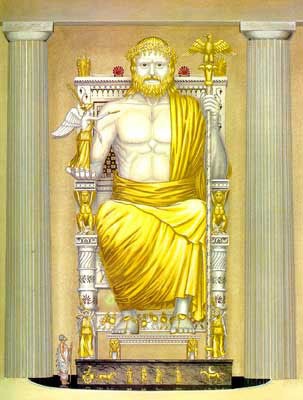
Throughout its existence, the statue has been restored several times. The statue of Zeus in Greece was damaged by lightning, earthquakes, and there were cases of theft of its gold parts. The Romans paid particular attention to it. So the emperor Caligula in 40 year was going to bring to Rome statues and images of all significant monuments of conquered Greece, this list also included the statue of Zeus. But according to legend, during the work, the statue burst out laughing, and everyone fled in wild fear, and the statue still remained in Olympia. It was last mentioned in 363 AD. After the adoption of Christianity in 391, all pagan temples were closed, and the temple of Zeus was destroyed. There are mentions that the statue of Zeus was transported to Constantinople somewhere at the beginning of the 5th century, where, according to the Byzantine historian Kedren, it was completely destroyed as a result of a fire in 475.
Zeus statue in Olympia. Short description
The statue was covered with a huge woolen curtain dyed with Phoenician purple. The curtain, contrary to all established traditions, did not move apart or rise, but, on the contrary, fell down on the ropes, revealing the majestic image of Zeus to the visitor of the temple.
The statue of Olympian Zeus was made of gold and ivory, using the so-called chryso-elephantine technique. To decorate the statue, they brought 200 kilograms of pure gold. According to the description of his contemporaries, Zeus sat on a throne, his head was decorated with a wreath, in his right hand he held the goddess of victory Nika, in his left - a scepter crowned with an eagle. Zeus's cloak was decorated with images of animals and flowers. Zeus' feet rested on the bench. The throne towered on a huge pedestal - 9.5 by 6.5 meters.

Special attention was paid to decorating the throne of the wonder of the world of the statue of Zeus at Olympia. It was made of ebony, gold, ivory and precious stones... The throne was abundantly filled with images of scenes from ancient Greek mythology. Each leg of the throne contained four Nicky, on the crossbars between the legs scenes of the war between the Greeks and the Amazons and sports competitions were presented. The throne was painted by Phidias' brother, the artist Panen. The scenes contain images of the famous Hercules, Theseus, Prometheus, Achilles, Apollo, Artemis, Helios, Hera, Hermes, Aphrodite, Athena, Poseidon. Of course, among these pictures, Zeus himself is personally present.
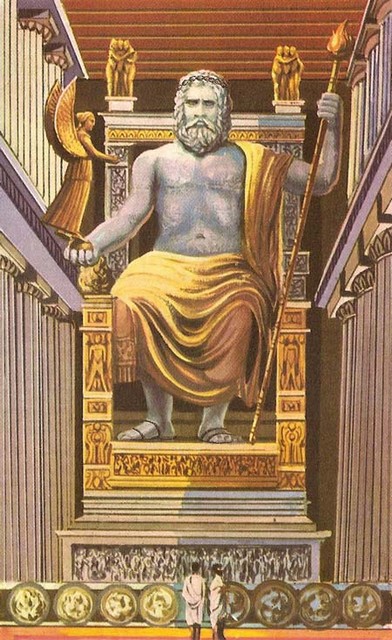
But most of all, of course, amazed the size of the statue of Zeus in Ancient Greece. The right palm was at the height of the columns of the first tier of the temple, and the head was at the level of the second tier. Strabo even got the impression that if Zeus had risen from his throne, the roof of the temple would have been broken. According to modern opinions, the overall height of the statue is estimated to be from 12 meters to 17 meters.
Zeus statue in Olympia. Interesting Facts
To preserve the ivory, the priests anointed the statue with oil. This protected her from the "swampy air". In the Athenian Acropolis, on the other hand, because of the dry air, the statue of Athena was moistened with water. The floor of the statue was covered with black marble with an artificial depression, like a pool, into which oil dripped. Another purpose for the pool was associated with the illusion of light - the light from the door reflected off the oil and illuminated the head and shoulders of the statue, giving the impression that it is God who is emitting light to people.
The statue of Olympian Zeus is the work of Phidias. An outstanding work of antique sculpture, one of the former seven wonders of the world. It was located in the temple of Olympian Zeus, in Olympia - a city in the region of Elis, in the north-west of the Peloponnese peninsula, where from 776 BC. NS. to 394 AD NS. every four years, the Olympic Games were held - competitions of Greek and then Roman athletes. The Greeks considered unhappy those who did not see the statue of Zeus in the temple.
Creation of the temple
The Olympic Games have been held for over 300 years. They were very popular with the people. They were held in honor of the god Zeus. But in Greece, the main temple in honor of Zeus has not yet been erected. In 470 BC. NS. in Greece began to collect donations for the construction of this temple. The construction of the temple began in 470 BC. NS. and ended in 456 BC. NS. The construction was supervised by the architect Libon, information about which has not reached us.
Description of the temple
According to legend, the temple was magnificent. The entire temple, including the roof, was built of marble. It was surrounded by 34 massive shell rock columns. Each was 10.5 meters high and more than 2 meters thick. The area of the temple was 64 × 27 m. On the outer walls of the temple there were slabs with bas-reliefs depicting the 12 labors of Hercules. Bronze doors, 10 meters high, opened the entrance to the religious premises of the temple. In the 5th century BC. the citizens of Olympia decided to build a temple to Zeus. The magnificent building was erected between 466 and 456. BC. It was built of huge stone blocks and was surrounded by massive columns. For several years after the completion of construction, there was no worthy statue of Zeus in the temple, although it was soon decided that it was necessary. A famous Athenian sculptor was chosen as the creator of the statue.
Making the statue
The construction of the temple took about 10 years. But the statue of Zeus did not appear in it immediately. The Greeks decided to invite the famous Athenian sculptor Phidias to create a statue of Zeus. Phidias managed by this time to create two famous statues of Athena ("Athena Promachos" and "Athena Parthenos." Unfortunately, none of his creations have survived to this day). By his order, a workshop was built 80 meters from the temple. This workshop exactly matched the size of the temple. There he, with his two assistants, who he needed only as garbage collectors, behind a huge purple curtain created a statue of the God of Thunder in the chryso-elephantine technique. Phidias himself was very picky about the material that was delivered to him. He was especially picky about ivory, from which he created the body of a god. Then, under heavy guard, precious stones and 200 kg of pure gold were brought into the temple at the feet of the thunderer. According to current prices, the cost of the gold alone, which went to decorate the statue, was about $ 8 million.
Description of the statue
A cape that covered part of Zeus's body, a scepter with an eagle that he held in his left hand, a statue of the goddess of victory - Nike, which he held in his right hand, and a wreath of olive branches on Zeus's head were covered with gold. Zeus' legs rested on a bench supported by two lions. The throne reliefs glorified, first of all, Zeus himself. Four dancing Nicky were depicted on the legs of the throne. There were also depicted centaurs, lapiths, the exploits of Theseus and Hercules, frescoes depicting the battle of the Greeks with the Amazons. The base of the statue was 6 meters wide and 1 meter high. The height of the entire statue, together with the pedestal, was, according to various sources, from 12 to 17 meters. The impression was "that if he (Zeus) wanted to get up from the throne, he would have blown the roof off." Zeus's eyes were the size of a grown man's fist.
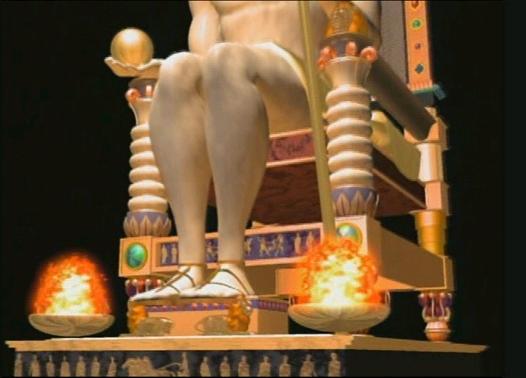
"God sits on a throne, his figure is made of gold and ivory, on his head he has a wreath like olive branches, on his right hand he holds the goddess of victory, also made of ivory and gold. She has a band and a wreath on her head. In the left hand of the god is a scepter, decorated with all kinds of metals. The bird sitting on the scepter is an eagle. The shoes of the god and outer clothing are also made of gold, and on the clothes there are images of various animals and lilies of the field "( Pausanias. "Description of Hellas".)
Zeus the Thunderer was the main god of the ancient Greeks. Together with his wife Hero and children, he, according to legend, lived at the top of Olympus - the most high mountain in the Balkans, located in Northern Greece. Hence the name of the classic gods ancient greece- "Olympic". Following Mount Olympia, the city on the Peloponnese peninsula, where sports competitions were held in antiquity, received the name Olympia. The Greeks believed that Zeus himself bequeathed them to compete in strength, speed and dexterity. At first, only the inhabitants of Elis participated in the games, but very soon the glory of the Olympic Games spread throughout Greece, and warriors began to come here. But armed people were not allowed near Olympia, explaining to them that they needed to win by strength and dexterity, and not with iron.
During the Olympic Games, wars in Greece stopped.
In the V century. BC NS. the inhabitants of Olympia decided that there was no need for Zeus to look at the competitions from the top of the mountain, but it would be good for him to move closer to the sports capital. Therefore, they erected a temple in honor of the Thunderer on the city square. The building turned out to be large and beautiful. It reached 64 in length, 28 in width, and inside the height, from floor to ceiling, was equal to 20 meters. The Greeks themselves did not consider this building outstanding: there were many other beautiful buildings in their country. The famous sculptor Phidias carved the figure of the god from wood and overlaid it with slabs of pink ivory, and therefore the body seemed alive. The Thunderer sat on a huge gilded throne. In one hand he held a symbol of power - a scepter with an eagle; in the open palm of the other hand stood a statuette of Nika, the goddess of Victory.
According to legend, when Phidias finished his work, he asked: "Are you satisfied, Zeus?" There was a thunderclap in response, and the floor in front of the throne cracked.
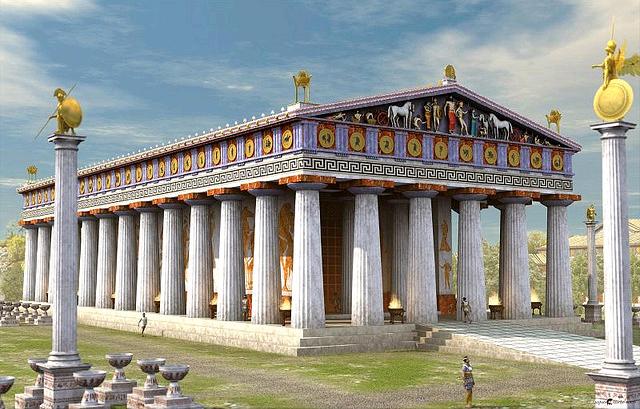
For seven centuries Zeus, smiling benevolently, watched the athletes, while in the II century. n. NS. there was no powerful earthquake that severely damaged the statue. But the games in Olympia continued anyway: the athletes believed that if not the temple statue, then the god himself, sitting on the top of the mountain, helped them. The end of sports was put in 394 by the Christian emperor Theodosius I, who had banned all pagan cults two years earlier.
After the ban of the Olympic Games, thieves ripped off the statue of Zeus, stealing gold and ivory. All that's left of famous sculpture Phidias, was taken from Greece to the city of Constantinople, but there the wooden sculpture burned down during a strong fire. This is how the third wonder of the world perished, but the Olympic Games founded, according to legend, by the Thunderer were restored in late XIX centuries and now they collect athletes from all over the world, ready to measure their strength in the most different types sports.
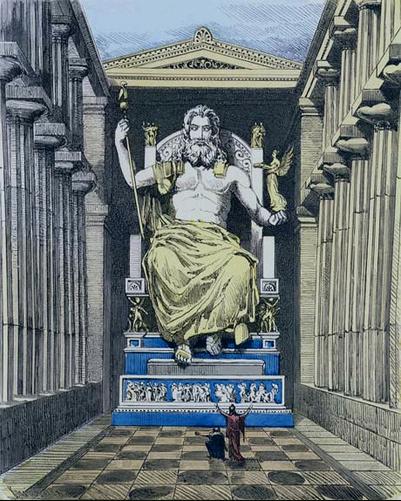
Opening the statue
In 435 BC. NS. the grand opening of the statue took place. The most influential people of Greece came to see Zeus. They were amazed at what they saw. The Thunderer's eyes sparkled brightly. The impression was that lightning was born in them. The entire head and shoulders of the god shone with divine light. Phidias himself went into the depths of the temple and from there watched the enthusiastic audience. In order for the head and shoulders of the Thunderer to sparkle, he ordered to cut down a rectangular pool at the foot of the statue. Olive oil was poured over the water in it: a stream of light from the doors falls on a dark oily surface, and the reflected rays rush upward, illuminating the shoulders and head of Zeus. A complete illusion arose that this light was pouring from God to people. They said that the Thunderer himself descended from heaven in order to pose for Phidias. The fate of Phidias himself still remains unknown. According to one version, after 3 years, he was convicted and thrown into prison, where he died soon. According to another version, he lived for another 6-7 years, becoming an outcast in his old age, and died in oblivion.
A contemporary wrote :
“Has God come down to earth and showed you, Phidias, his image?
Or you yourself, to see God, ascended to heaven? "
The fate of the third wonder of the world
About 40 g. NS. the Roman emperor Caligula wanted to move the statue of Zeus to himself in Rome. Workers were sent for her. But, according to legend, the statue burst out laughing, and the workers fled in horror. The statue was damaged after an earthquake in the 2nd century BC. e., then it was restored by the sculptor Dimofont. In 391 AD. NS. the Romans, after the adoption of Christianity, closed the Greek temples. Emperor Theodosius I, who established Christianity, banned the Olympic Games as part of a pagan cult. Finally, only the foundation, some columns and sculptures remained from the temple of Olympian Zeus. The last mention of her dates back to 363 AD. NS. At the beginning of the 5th century A.D. NS. the statue of Zeus was transported to Constantinople. The statue burned down in a temple fire in 425 AD. NS. or in a fire in Constantinople in 476 AD. NS.
The history of the appearance of the statue of Zeus in Olympia is associated with sports games, which were traditionally held once every 4 years. At this time the earth Ancient Hellas turned into a special territory, because the goal of the Olympic Games was not only competitions - one of their goals was to unite disparate city-states.
Their inhabitants became participants in competitions that competed only with the strongest rivals. Since the Olympic Games were a large-scale event and brought together representatives from Egypt, Syria, Asia Minor and Sicily to compete, a more spacious structure was required to hold them. Based on this need, the authorities of Olympia decided to build a large temple that could freely accommodate all those present, because the first sanctuary of Zeus, built 150 km from the city of Athens, was no longer suitable for such a purpose.
The construction of the new church took about 15 years, and the architect Lebon supervised the construction work. Finally, in 456, the Temple, or the House of Zeus, appeared on the display of the townspeople. The temple was built in the spirit of the famous sanctuaries of Olympia, but it significantly surpassed them all combined, both in size and design. So, the Zeus building was adorned on a rectangular platform, and its roof was supported by 13 columns of 2-meter diameter. They reached a height of up to 10 m. In total, 34 columns were needed to decorate the newest construction.
However, no matter how majestic the temple was, it simply did not seem complete without its deity, and another famous master, the sculptor Phidias, hastened to Athens at the invitation of the government. The task before him was this - to create a statue of Zeus in the best possible way, and the sculptor did not disappoint.
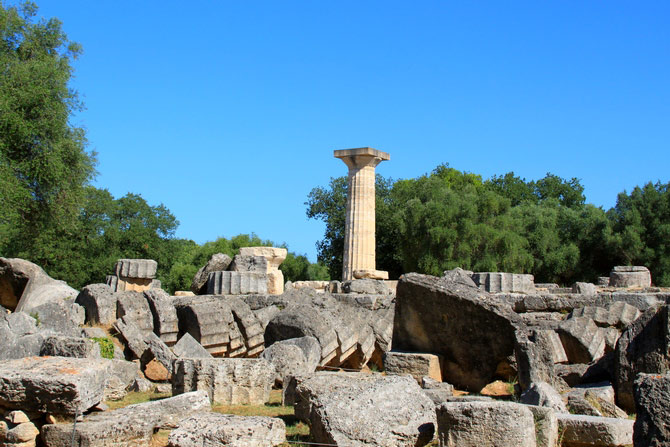
Description of the statue of Olympian Zeus
When the work of the master was completed, the inhabitants of Olympia gasped - in front of them stood huge statue Zeus (according to various sources, the height of the sculpture of the Thunderer was from 12 to 17 m). It took about 200 kg of gold to make a structure of unprecedented beauty. If we translate them into a monetary equivalent, then today such an amount of precious metal can be estimated at $ 8 million, and even more.
The deity revered by the Olympians occupied a throne made of ivory, gold, precious stones and ebony. The head of the Thunderer was crowned with branches of an olive tree - a symbol of peacefulness. The statue itself was made of pink ivory, so it felt alive, lifelike. In one hand, Zeus held a figurine of the goddess Nike, and with the other he leaned on a scepter decorated with a golden eagle.
Installed on a dais, the statue of the deity corresponded in height to a 4-storey building. It's amazing how accurately Phidias was able to calculate the size of the sculpture, because it almost rested against the ceiling, but still did not touch it. The majestic Zeus sat on the throne naked to the waist, but his body was covered with a golden cape, decorated with drawings of flowers and animals. The thunder god's feet were on the bench. The throne was installed on a pedestal, the dimensions of which were also impressive (9.5 x 6.5 m).
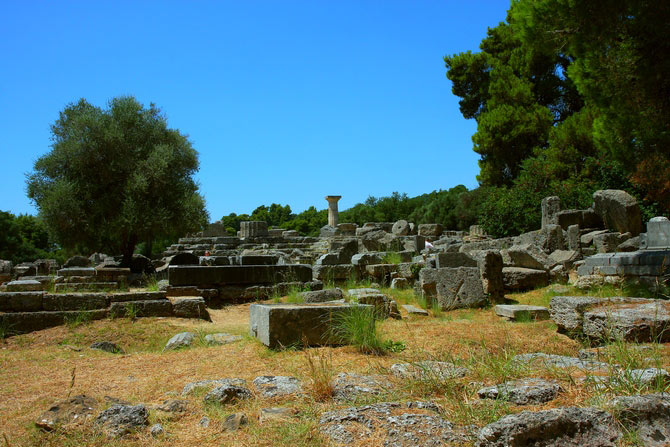
The master approached the decoration of the throne no less responsibly - he filled it with images containing mythological scenes of the ancient Greek land. On the legs of the throne were 4 goddesses Nike. On the crossbars connecting the legs, scenes of sports competitions or wars were depicted. The master Panenom, Phidias' brother, was responsible for the quality of the painted work on the throne. In the scenes transmitted through his skill, images of the deities known to the Greeks were involved: Prometheus, Apollo, Achilles, Poseidon, Hercules, Hera, Artemis, Athena, Aphrodite and the God of Thunder himself.
The admiration of the parishioners of the House of Zeus knew no bounds, because the frame of the statue was covered with ivory plates playing the role of leather, and the so-called robe was made of pure gold. But the joints between the materials were hidden so carefully that the statue of Zeus at Olympia looked like a monolithic object. When looking at the deity, it seemed to people that if it suddenly rose from the throne, it would break through the roof of the temple. The builders knew that there would be countless people who wanted to see Zeus, so they built special platforms for spectators along each wall of the temple. Thus, each person who came to the temple had the opportunity to see the face of the deity as close as possible.
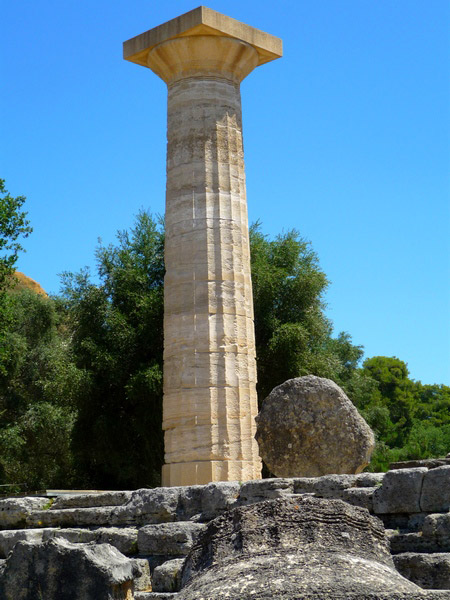
According to Phidias' order, a pool was set up at the foot of the statue and first filled with water, and then with olive oil (above). The light that penetrated the open doors of the structure and fell on the pool was reflected in the oily dark smooth surface of the water, mysteriously enveloping the face and shoulders of the sculpture. The whole figure of the Thunderer gleamed due to the regular processing of olive oil. This was done to avoid the formation of cracks in the ivory - it is sensitive to moisture. This activity was performed by the priests daily. According to Pausanias, the oil was extremely beneficial for the statue of Olympian Zeus, as it protected it from the damage that Altis's swampy air could bring. The floor in front of the statue was paved with black marble, and this separated space was bordered by a raised strip made of Parian marble. She also held back the draining oil.
The grandeur of the statue was so amazing that the person standing next to him experienced two opposite feelings at the same time. On the one hand, it was an animal fear of a deity, on the other, awe. The most impressionable pilgrims fell at the feet of the deity and did not raise their heads for a long time - they were afraid to feel the stern gaze of their god on themselves.
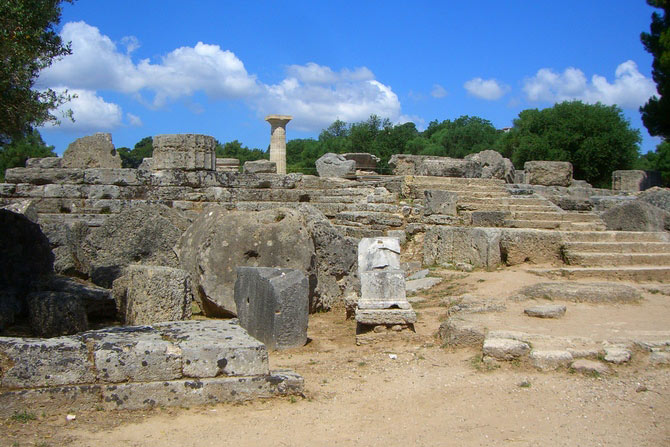
And what about the famous Phidias? Feeling pride in his creation, he often watched the reactions of visitors, but he did it secretly, hiding in the depths of the temple. It was especially pleasant for him to see how gifts are presented to the statue. There was no special place for this purpose, so the gifts were directly hung on the throne or even on the sculpture itself. The news of the beautiful statue, which became one of the seven wonders of the ancient world and the landmark of Olympia, was passed from mouth to mouth and quickly spread throughout the entire ancient people.
The fate of the statue of Zeus
The following can be said about whether there were attempts on the statue of amazing beauty. Knowing about the existence of a masterpiece sculpture, Emperor Caligula gave his subordinates the order to bring from Greece a statue of Zeus and images of other gods that were of artistic value. His plans were to take away the heads of the deities, and put his own in their place. The conqueror of Greece named Paul Aemilius was also going to take the statue of Zeus with him to Rome. However, neither Caligula nor Paul succeeded - the giant sculpture remained in its place. According to the legend, the statue just burst out laughing at the attempt to steal it, and the frightened workers sent by the masters fled in horror.
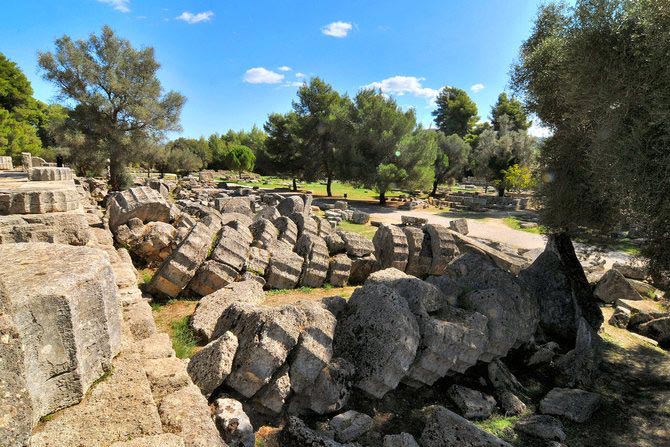
V different times the sculpture of the deity has undergone restoration. For example, the sculptor Damathon Messensky restored it in the Hellenistic era, and under Julius Caesar it was put in order after being damaged by lightning. The history of the statue of Zeus has several attempts to steal some of its parts. The facts of the disappearance of two golden curls of Zeus and the theft of the athlete's figure were described by Lucian and Pausanias in their time.
In general, the statue of Zeus in Olympia delighted the eye of the parishioners of the temple for almost 800 years. But when Theodosius I, the Roman emperor who converted to the Christian faith, eventually came to power, sports in Olympia were banned as a pagan event. This explains the closure of the temple of Zeus in the middle of the 3rd century. It ceased to be of cultural value, and looters raged, ripping precious stones, gold and ivory from the statue. Those in power decided to keep the valuable statue, and in 363 it was safely moved to Constantinople. But in the 5th century, during a fire in the Byzantine palace of the Roman emperor, the unique creation of the talented Phidias burned down.
In 1829, a group of French archaeologists excavated the alleged site of the Temple of Zeus. They managed to find the outlines of the temple itself and some fragments of sculptures and bas-reliefs depicting the exploits of Hercules. Today, the found exhibits of historical value can be seen in the Paris Louvre.

After 46 years, German archaeologists visited Olympia, who were a little more fortunate - they have already found much more fragments of legendary sculptures than their predecessors, the foundation of the temple and even a pool, which for the revered Zeus was filled with water and olive oil.
To this day, the ruins of the temple of Zeus remain attractive to numerous tourists, but the former mystery and enigma is not felt when you are in this legendary place. Everything that has come down from antiquity to our contemporaries is a few pillars, half destroyed.
They say that the statue of Zeus in Olympia turned out to be so majestic that when Phidias, having created it, asked his creation: "Are you satisfied, Zeus?" - thunder struck, and the black marble floor at the feet of the god cracked. The Thunderer was pleased.
Despite the fact that only memories of one of the most majestic statues of this magnitude have come down to us, the mere description of the monument, which was in its way a real jewelry masterpiece, cannot but amaze the imagination. Both before and after the creation of the statue of Olympian Zeus, people did not create a monument of this scale - and it is not a fact that they will ever create it: this wonder of the world turned out to be too expensive in cost and huge in scale.
The uniqueness of this monument also lies in the fact that the statue of Olympian Zeus is the only one of all the wonders the ancient world was located on the territory of continental Europe, in Greek city Olympia, which is located on the Balkan Peninsula.
The role of the Thunderer in the life of Olympia
The Thunderer was connected with this city in the most direct way - it was here that he managed to defeat his father, Cronus, who was predicted that one of his sons would deprive him of power. To avoid this, he solved the problem in a rather bloodthirsty way - he devoured all the boys who were born. Only Zeus was lucky: his mother, Rhea, managed to save the baby.
To celebrate this event in a dignified manner, the inhabitants of the city decided to hold the Olympic Games once every four years, and three hundred years after their start, in 471 BC, they decided to build a worthy sanctuary for the Thunder God and install in it sculpture of a god. This process turned out to be long - construction work lasted fifteen years and the opening of the temple took place in 456 BC.
What the house of Zeus looked like
- The width of the temple is 64 m, and the length of the sanctuary is 27 m;
- The building was completely built of marble (including the roof);
- The sanctuary was surrounded by thirty-four columns, the height of which was 2.6 m, and the thickness was about two. They were made from a special type of limestone, consisting of pressed shells and their fragments;
- On the outer walls of the building were installed bas-reliefs depicting the twelve labors of Hercules;
- It was possible to enter the sanctuary through doors made of bronze, their height was 19 m.
Despite all its greatness, the temple stood for a long time without the statue of the Thunderer, until the work on it was entrusted to almost the most famous master of that time, Phidias.
Who is Phidias
Before creating the world-famous wonder of the world, Phidias was already famous for the magnificent one in the Parthenon. He developed a plan for the reconstruction of the capital of Greece, thanks to which he managed to amass spiteful critics. As a result of their intrigues, the craftsmen were accused of stealing gold and ivory, which he allegedly stole while working on Athena, because of which the sculptor ended up in prison.

True, he was not there for long: the author of the famous works had many admirers, therefore, when the inhabitants of Elis made a deposit for Phidias, he was released to Olympia, where he worked on the Thunder God for about ten years (Kolot, his student, and a close relative , artist Panen).
Workshop
They created the statue of the Thunderer in a specially built room, located not far from the sanctuary. In size, it was not much smaller than the temple of Zeus - German archaeologists found a workshop, whose attention was attracted by the remains of an ancient building located near the sanctuary.
When inspecting the building, they found the tools with which the craftsmen created the sculpture, and the remains of the foundry, which confirmed the version that it was here that one of them was created.
A pit with defective parts of the statue was found near the workshop, and direct evidence was found that Phidias created his sculpture exactly as it was described in the annals. They turned out to be ready-made forms of the god's clothing, a huge number of ivory plates, remains and nails.
One of the main finds directly related to the sculptor turned out to be the bottom of a jug with the words scratched on it: "I belong to Phidias."
What the statue of the Thunderer looked like
The statue of Zeus in Olympia took a long time to create: Phidias spent about ten years on it. When she appeared before the inhabitants and guests of Olympia in 435 BC, she was a real wonder of the world.
The exact dimensions of the statue have not yet been determined, but apparently, its height ranged from 12 to 17 meters. Zeus, naked to the waist, sat on the throne, his legs were on a bench supported by two lions. The pedestal on which the throne was located was quite huge: its dimensions were 9.5 by 6.5 m. Ebony, gold, ivory and jewelry were used for its manufacture.
The throne itself was decorated with images of scenes from the life of Greek celestials, the goddesses of victory danced on its legs, and the battles of the Greeks with the Amazons were captured on the crossbeams, and, naturally, the Olympic Games were not without (Panen was engaged in painting). Made the Thunderer from ebony, with his entire body covered with ivory plates the highest quality... The master selected materials for his statue very meticulously.
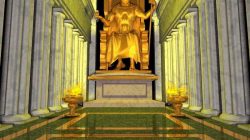
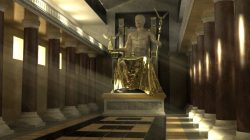

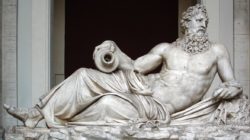
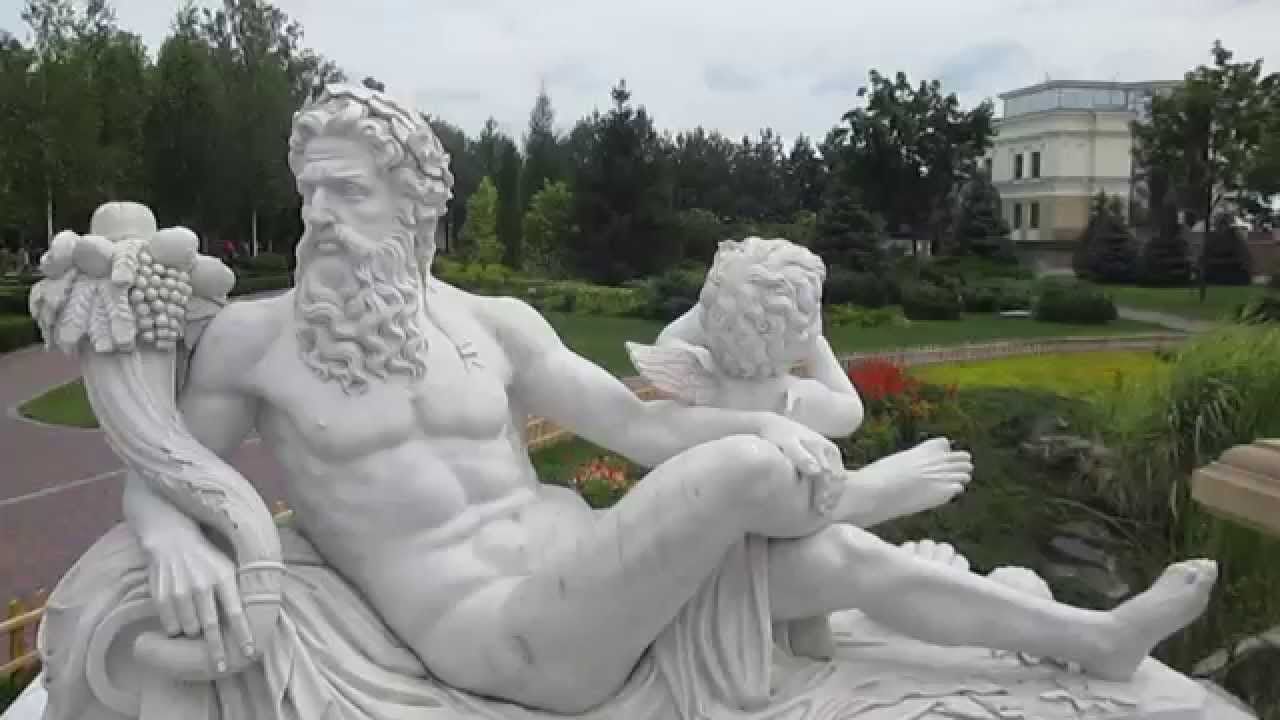

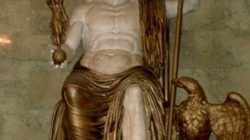
On the head of the supreme god was a wreath, and in one hand he held the golden Nika, the goddess of Victory, in the other - a scepter decorated with an eagle, symbolizing the supreme power. The god's clothes were made of gold sheets (all in all, it took about two hundred kilograms of gold to make the sculpture). The thunderer's cloak was decorated with images of representatives of the animal and plant world.
Opening the statue
At the opening of this wonder of the world came the most famous residents ancient Greece. When the veil hiding the monument was removed, everyone was amazed: the head and shoulders of the statue of Zeus emitted divine light that poured from God to people, and the eyes shone so brightly that it seemed as if they were emitting lightning.
The author achieved this effect in a very interesting way: Phidias ordered a rectangular pool in the marble floor to be cut out at the foot of the statue, filled with water, and dark olive oil poured on top. A stream of light rays entering the temple through the doors fell on the oily surface and reflected upward from it, illuminating the head and shoulders of the Thunderer.
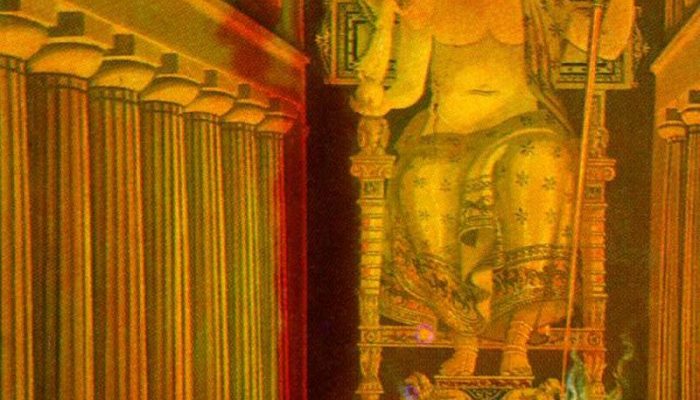
This pool served another, more practical function - so that the ivory does not deteriorate, the priests smeared the statue with oil, which flowed directly into the depression.
The fate of the statue of the Thunder God
The statue of Olympian Zeus existed for quite a long time, during this time it was restored more than once: lightning often hit it, it survived several earthquakes. Also, there were frequent cases of theft of gold parts.
The Romans wanted to take the statue out more than once, for example, this was the order Caligula gave in 40. This could not be done: legends say that when the invaders came to take the monument, the statue of Zeus in Olympia burst out laughing, frightening the invaders to such an extent that they fled, and the Thunderer remained in place.
The last memory of the statue dates back to 363 AD. - when Christianity was officially adopted in Greece (this happened in 391), absolutely all pagan temples were closed, the same fate befell the temple of Zeus.
According to one version, the statue of the Thunderer burned down during the fire of the ancient sanctuary in 425 AD. According to the other, a little later, since there are mentions that in the 5th century the statue was transported to Constantinople, where it was for some time in the palace of Emperor Theodosius II and completely burned down there during the fire of 475 - only several charred ivory plates and molten gold pieces.
Where can you see a copy of the Thunderer
Nowadays, a marble copy of one of the wonders of the world can be seen in the Hermitage, where it was brought from Italy in 1861. Apparently, this statue of Zeus was created by a Roman author in the first century BC, and it was found during archaeological site in the vicinity of Rome at the end of the 18th century. It is notable for the fact that today it is one of the largest antique sculptures that are in museums in the world - the height of the monument is 3.5 meters and weighs 16 tons.
The sculpture was acquired in early XIX century one of the Italian collectors, the Marquis D. Campana.
It did not stay with him for long, because after a while he went bankrupt, his property was confiscated and sold at auction. Before the auction, the director of the Hermitage managed to persuade the Italian authorities to give him the opportunity to purchase some things before the sale, thus, the best exhibits from the collection of the ruined marquis, including the statue of the Thunderer, ended up in the Hermitage.
Zeus was one of the most revered gods among the ancient Greeks. According to ancient Greek mythology, he was the god of the sky, thunder and lightning, in charge of the whole world. Zeus is the chief of the Olympian gods. His attributes were considered a shield and a double ax (labrys), sometimes an eagle. He distributed good and evil on earth. Sometimes he was associated with fate, sometimes he himself acts as a creature subject to Moiras - fate, fate. He can foresee the future. He announces the destinies of fate through dreams, as well as thunder and lightning. The entire social order was built by Zeus. It was he who gave the people laws and established the rule of kings. Also, the Thunderer protects the family and home, monitors the observance of traditions and customs ...
The Olympic Games have been held in honor of Zeus for over 300 years. They were extremely popular with the people. However, in Greece until now there was no main temple in honor of the most respected deity of Ancient Greece ...
Legendary Olympia
The statue of Olympian Zeus is the only wonder of the world that has ended up on the European mainland. In the northwestern part of the Peloponnese (Southwestern Greece), in the valley between the Alpheus River and its tributary Kladeon, the city of Olympia was located, the fame of which spread far beyond the borders of the country. Zeus was directly related to Olympia. According to legend, it was here that he entered into a struggle with his father, the bloodthirsty and treacherous Cronus, who devoured his children, since the oracle predicted his death at the hands of his son. Saved by his mother, matured Zeus won the victory and made Crohn burp his brothers and sisters.
In honor of this victory, the so-called Olympic Games were established - regular festivities in honor of Zeus, which certainly included sports competitions. The Greeks believed that Zeus himself bequeathed them to compete in strength, speed and dexterity. At first, only the inhabitants of Elis participated in the games, but very soon the glory of the Olympic Games spread throughout Greece, and warriors began to come here. But armed people were not allowed near Olympia, explaining to them that they needed to win by strength and dexterity, and not with iron. The first Olympic Games were supposedly held in 776 BC. NS. After that, the games were held every four years for 1100 years. They were of great importance: during the games, all wars were stopped so that participants and spectators could easily get to their venue.
Temple of Olympian Zeus
 More than two centuries have passed since the establishment of the Olympic Games, and at the beginning of the 5th century BC. NS. the inhabitants of Olympia decided to restore justice to Zeus. By that time, the Temple of Artemis in Ephesus already existed, but there was no main temple dedicated to the Thunderer. In 470 BC. NS. throughout Greece began to collect donations for the construction of this temple. And already in 466 BC. NS. a grandiose construction was started. The construction was supervised by the architect Libon, details which, unfortunately, did not reach us. According to some reports, Libon was a native of Elis. Today we can say that he was a master of his craft, since the temple was a fully formed Doric peripter (the ratio of the number of columns is 6 to 13). The proportions of the temple were distinguished by severity and clarity.
More than two centuries have passed since the establishment of the Olympic Games, and at the beginning of the 5th century BC. NS. the inhabitants of Olympia decided to restore justice to Zeus. By that time, the Temple of Artemis in Ephesus already existed, but there was no main temple dedicated to the Thunderer. In 470 BC. NS. throughout Greece began to collect donations for the construction of this temple. And already in 466 BC. NS. a grandiose construction was started. The construction was supervised by the architect Libon, details which, unfortunately, did not reach us. According to some reports, Libon was a native of Elis. Today we can say that he was a master of his craft, since the temple was a fully formed Doric peripter (the ratio of the number of columns is 6 to 13). The proportions of the temple were distinguished by severity and clarity.
Construction was completed in 456 BC. NS. According to legend, the temple was magnificent. The entire temple, including the roof, was built of marble. It was surrounded by 34 massive shell rock columns. Each was 10.5 meters high and more than 2 meters thick. The temple itself had an area of 27.68 × 64.12 square meters, and the highest height of the interior was just under 20 meters. The Doric temple, which surpassed in size all the temples of that time, was built of limestone blocks and decorated with painted marble pediments (on one - the image of the competition between Pelops and Enomai, on the other - the battle of the Lapiths with centaurs) and metopes (slabs with bas-reliefs on which were depicts 12 labors of Hercules). Bronze doors 10 meters high opened the entrance to the religious premises of the temple.
For several years after the completion of construction, there was no worthy statue of Zeus in the temple. Pretty soon the Greeks decided it was necessary. A famous Athenian sculptor was chosen as the creator of the statue.
History of creation
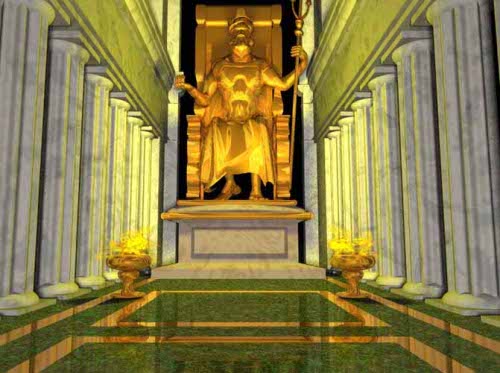 The construction of the temple took about 10 years. But the statue of Zeus, as already noted, did not appear in it immediately. For its construction, the Greeks decided to invite the famous Athenian sculptor Phidias. Phidias had managed by that time to create two famous statues Athens ("Athena Promachos" and "Athena Parthenos"; unfortunately, none of his creations have survived to this day). Subsequently, he became known not only for the statue of Olympian Zeus, but also for the reliefs on the walls of the temple. It is known that, together with Pericles, Phidias developed a plan for rebuilding and decorating Athens, which, however, cost Phidias dearly: the enemies of his powerful friend and patron became the enemies of the sculptor. Their revenge was then trivial and dirty, but the inhabitants craved a scandal: Phidias was accused of hiding gold and ivory during the construction of the statue of Athena in the Parthenon. However, the fame of the sculptor turned out to be stronger than the spiteful critics. The inhabitants of Elis posted a bond for the prisoner, and the Athenians considered this pretext sufficient to allow Phidias to work at Olympia. For several years Phidias remained in Olympia, constructing a statue - syncretic in material and known to us today from descriptions and images on coins.
The construction of the temple took about 10 years. But the statue of Zeus, as already noted, did not appear in it immediately. For its construction, the Greeks decided to invite the famous Athenian sculptor Phidias. Phidias had managed by that time to create two famous statues Athens ("Athena Promachos" and "Athena Parthenos"; unfortunately, none of his creations have survived to this day). Subsequently, he became known not only for the statue of Olympian Zeus, but also for the reliefs on the walls of the temple. It is known that, together with Pericles, Phidias developed a plan for rebuilding and decorating Athens, which, however, cost Phidias dearly: the enemies of his powerful friend and patron became the enemies of the sculptor. Their revenge was then trivial and dirty, but the inhabitants craved a scandal: Phidias was accused of hiding gold and ivory during the construction of the statue of Athena in the Parthenon. However, the fame of the sculptor turned out to be stronger than the spiteful critics. The inhabitants of Elis posted a bond for the prisoner, and the Athenians considered this pretext sufficient to allow Phidias to work at Olympia. For several years Phidias remained in Olympia, constructing a statue - syncretic in material and known to us today from descriptions and images on coins.
In 440 BC. NS. Phidias began to create the statue. A year earlier, he had developed a technique for preparing vast quantities of gold and ivory for construction. By order of Phidias, a workshop was built 80 meters from the temple. It exactly matched the size of the temple. There he and his two assistants, whom he needed only as garbage collectors, behind a huge purple curtain, created a statue of the thunderer god in the chryso-elephantine technique. According to the Greeks themselves, the statue of Zeus is the most greatest creation Phidias. It is believed that the greatness and beauty of the image of Zeus was revealed to Phidias in the verses of the Iliad.
During the construction, Phidias and his assistants created, first of all, a wooden frame, which was supposed to serve as a skeleton for the statue of Zeus. After that, they covered the frame with ivory plates, representing the skin of the god, and gold sheets, representing his robe. The workers hid the joints so that the completed statue looked like a monolithic figure. It is known that Phidias himself was very picky about the material that was delivered to him. He was especially picky about ivory, from which he created the body of a god. Under heavy guard, precious stones and 200 kg of pure gold were delivered to the temple at the feet of the thunderer. According to modern rates, the cost of the gold alone, which went to decorate the statue, was about $ 8 million.
When the construction of the statue was completed, it barely had enough space in the temple. Strabo wrote: “... although the temple itself is very large, the sculptor is criticized for not taking into account the real ratio of the proportions of the statue and the size of the temple. He showed Zeus sitting on the throne, but with a head that almost rests on the ceiling, so that we get the impression that if Zeus gets up, his head will blow off the roof of the temple. "
According to the works of ancient historians, numerous retellings and archaeological finds (small copies, images on coins), we can judge how this sculpture of an ancient Greek deity looked like.
Description of the statue of Zeus
The figure of the main Greek deity sitting at the end of the hall on the throne was 12 meters 40 centimeters high (some sources call the numbers 13, 14 and even 20 meters), which is equal to the height of a four-five-story building. There is evidence that the statue literally touched the head of the temple's ceiling, but not all sources confirm this fact, considering this to be a clear exaggeration. The base of the statue was 6 meters wide and 1 meter high.
It should be noted that for the first time in Greek art Phidias created the image of a merciful god, he gave the image of Zeus an expression of kindness and deep humanity. An olive wreath adorned the head of the god of thunder, a beard framed his face in wavy strands, a cloak fell from his left shoulder, covering part of his legs. The figure of Zeus was made of wood, and on this base with the help of bronze and iron nails, special hooks were attached parts of ivory (in Greek - "elephas") and gold (in Greek - "chrysos"). That is why this technique is called chrysoelephantine. At that time, it was considered the pinnacle of art, since it amazed the eyes of the layman with its reality and grandeur. The face, hands, and other exposed parts of the body were of pinkish, warm ivory, the hair and beard, the wreath, cloak and sandals were of gold, and the eyes were of precious stones. Travelers who saw Zeus in Olympia called the combination of power and mercy, wisdom and kindness in his image as strange.
“God sits on a throne, his figure is made of gold and ivory, on his head he has a wreath like olive branches, on his right hand he holds the goddess of victory, also made of ivory and gold. She has a bandage and a wreath on her head. In the left hand of the god is a scepter adorned with all kinds of metals. The bird sitting on the scepter is an eagle. God's shoes and outerwear are also made of gold, and on the clothes there are images of various animals and lilies of the field ”, - this is how Pausanias told about what he heard in his“ Description of Hellas ”(II century AD). Thus, in his right hand on an open palm, he held the figure of the goddess of victory Nike, and with his left he leaned on a high rod - a symbol of power - a scepter with an eagle.
The throne was made, according to some sources, from cedar, according to others - from ebony and covered with gold and ivory. The side walls were painted by the artist Panain, Phidias' relative and assistant. The legs of the throne were decorated with figures of the dancing Nika, the goddess of victory. The arms of the throne were supported by sphinxes, and its back was adorned by the Harites - the goddess of Beauty, the daughter of Zeus and Hera. In front of the pedestal depicting the scene of the birth of Aphrodite, a small pool was arranged, lined with blue Eleuxine stone and white marble. He served, according to the same ancient Greek writer Pausanias, to drain the remnants of olive oil, with which the statue was regularly lubricated. Along the walls of the temple, platforms for spectators were built so that people, having climbed them, could see the face of God.
Grand opening
In 435 BC. NS. the grand opening of the statue took place. The most influential people of Greece came to see Zeus. They were amazed at what they saw. The Thunderer's eyes sparkled brightly. The impression was that lightning was born in them. The entire head and shoulders of the god shone with divine light. Phidias himself went into the depths of the temple and from there watched the enthusiastic audience. In order for the head and shoulders of the Thunderer to sparkle, he ordered to cut down a rectangular pool at the foot of the statue, which we have already mentioned. Olive oil was poured over the water in it: a stream of light from the doors fell on the dark oily surface, and the reflected rays rushed upward, illuminating the shoulders and head of Zeus. There was a complete illusion that this light was pouring from God to people. They said that the Thunderer himself descended from heaven in order to pose for Phidias. A contemporary wrote: "Did God come down to earth and showed you, Phidias, his image, or did you yourself, to see God, ascend to heaven?" Applying gold and ivory plates to wood required the finest craftsmanship. The great art of the sculptor was combined with the painstaking art of the jeweler. Zeus was so majestic that, according to legend, when Phidias completed his work, he approached the statue, as if floating above the black marble floor of the temple, and asked: "Are you satisfied, Zeus?" There was a thunderclap in response, and the floor at the statue's feet cracked. Zeus was pleased.
The fate of Phidias himself still remains unknown. According to one version, after 3 years, he was convicted and thrown into prison, where he died soon after. According to another version, he lived for another 6-7 years, becoming an outcast in his old age, and died in oblivion. However, Phidias' creation was highly esteemed by the descendants. The famous Roman orator and politician Cicero (1st century BC) called Olympian Zeus the embodiment of beauty, the Roman writer and scientist Gaius Pliny the Elder (1st century AD) considered sculpture to be an incomparable masterpiece. The Greeks themselves did not consider the Temple of Zeus an outstanding building: there were many other beautiful buildings in their country. But nowhere else was there such a unique statue of Zeus as in this Olympic Temple! That is why through the centuries we, having chosen Olympia as a miracle, remember not a temple, not a sanctuary, but only the statue of the Thunderer that stood inside.
Transfer and death of the statue
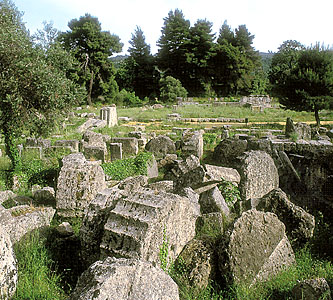 Around 40 AD NS. the Roman emperor Caligula wanted to move the statue to Rome. Workers were sent for her, but, according to legend, the statue burst into laughter and the workers fled.
Around 40 AD NS. the Roman emperor Caligula wanted to move the statue to Rome. Workers were sent for her, but, according to legend, the statue burst into laughter and the workers fled.
For seven centuries Zeus, smiling benevolently, watched the athletes, until in the II century AD. NS. there was no powerful earthquake that severely damaged the statue. But the games in Olympia continued anyway: the athletes believed that if not the temple statue, then the god himself, sitting on the top of the mountain, helped them. The statue was restored by the sculptor Dimofont.
In 391 A.D. e., after the adoption of Christianity, the Greek temples were closed. Emperor Theodosius I, who established Christianity, banned the Olympic Games as part of a pagan cult in 394 (two years earlier, all pagan cults were banned). After the ban of the Olympic Games, thieves ripped off the statue of Zeus, stealing gold and ivory. All that remained of the famous sculpture of Phidias, the Byzantine emperors (according to some sources, at the initiative of wealthy Greeks) were subsequently transported with all precautions to Constantinople. Although they were Christians, no one raised a hand against Zeus. Even Christian fanatics, enemies of pagan beauty, did not dare to destroy the statue. At first, the Byzantine emperors allowed themselves to appreciate high art, and therefore collected all of its best works. But, to the deep satisfaction of Christian preachers, God punished his pagan rival, thereby punishing the emperors who had left the righteous path. In the 5th century AD (presumably in 462 or 476), the palace of Emperor Theodosius II was destroyed by fire. The wooden colossus became the prey of fire: only a few charred bone plates and sparkles of molten gold remained from the great creation of Phidias.
Olympia continued to face failures - earthquakes, landslides, fires and floods. The temple was significantly damaged. Finally, only the foundation, some columns and sculptures remained from the Temple of Olympian Zeus. The last mention of him dates back to 363 AD. NS. An earthquake struck the Olympic region in the 6th century. The temple and the stadium were finally destroyed by floods, their remains covered with silt. This helped the fragments of Olympia survive for over a thousand years.
Copies of the statue were made, including a large prototype in Kureni (Libya). However, none of them have survived to this day. Early reconstructions such as Erlach's are today considered inaccurate. From the statue and the temple, only memories remain. This is how another wonder of the world perished, but the Olympic Games founded, according to legend, by the Thunderer were restored at the end of the 19th century and now they gather athletes from all over the world who are ready to measure their strength in a variety of sports.
Postscript: was there a statue?
When no trace remains of a monument, there is a temptation (often motivated) to attribute its existence to human imagination. A similar fate did not escape the statue of Zeus, especially since not a single copy has survived from it. In order to make sure that the statue existed and was exactly as described by contemporaries, it was necessary to find at least indirect evidence of its creation.
Already in our time, an attempt was made to find the workshop of Phidias. The construction of such a statue required many years of work, and therefore Phidias and his many assistants needed a solid room. The statue of Zeus is not a block of marble that can be left out in the open for the winter.
The attention of the German archaeologists, who carried out excavations in Olympia, was attracted by the remains of an ancient building, rebuilt into a Byzantine Christian church. Having examined the building, they were convinced that it was here that the workshop was located - a stone structure, slightly inferior in size to the temple itself. In it, in particular, were found the tools of labor of sculptors and jewelers and the remains of the foundry "shop". But the most interesting finds were made in the vicinity of the workshop - in a pit where for many hundreds of years craftsmen dumped waste and discarded parts of statues. There they managed to find cast forms of Zeus's toga, many ivory plates, chips of semiprecious stones, bronze and iron nails - in general, complete and indisputable confirmation that it was in this workshop that Phidias made a statue of Zeus, and exactly the same as the ancients told. And to top off all the evidence, in the heap of garbage, archaeologists also found the bottom of a jug, on which the words "I belong to Phidias" were carved.
You might think that rock was especially unkind to the wonders of the world, whose fate was so tragic. This is not true. Piles of rubbish, towering hills rising in the Middle East, in Central Asia, in India, China, - traces of cities that once existed there and completely disappeared from the face of the earth, from which not a single house or temple, and often the name, remained. Each year brings news of remarkable new discoveries by archaeologists, usually bearing a note of sadness. The murals in Penjikent told of a palace in that city that no one would ever see; the statue of the reclining Buddha, discovered in Central Asia, told about many Buddhist temples, of which not a trace remained; the lion capitals of the columns and the remains of massive altars in the city-temple, found in Colchis, tell of buildings and sculptures that were irretrievably lost ...
If you bring together all the outstanding monuments of antiquity, it turns out that hardly one in a hundred survived to this day. Fortunately, this has never deterred people from new attempts to build, sculpt, carve, paint - express themselves and their time in high art. And the little that has survived to this day makes it possible to imagine the art of the East, gives us the right to be proud of the great masters of the past, wherever they worked - in India, Syria, Japan, Burma, Ethiopia ...




